Your Challenge
Your challenge today is a tough one as each of today’s featured images is quite strong. Once again, I ask you to judge them by placing the strongest image first and your least favorite last. Your comment might look like this: 2, 3, 1, 4. Feel free to justify one or more of your choices. I will share my rankings with you here in the next blog post.
Sony Alpha 1 (a-1) Mirrorless Camera Body
Your truly, Arthur Morris/BIRDS AS ART Is offering his rarely used backup Sony a-1 (ILCE-1) mirrorless camera body in excellent plus plus condition for a ridiculously low $3,498.00. This body has been updated to Firmware 3.00 that reportedly improves Bird Face-Eye tracking to levels attained by the a1-ii. The camera has my current a-1 set-up on it. The sale includes the current Buttons and Dials Guide and the Info Sheet, the original product box, one battery, the charger, the camera strap, and insured ground shipping via major courier to lower-48 US addresses only. Your item will not ship until your check clears unless other arrangements are made.
Please contact artie via e-mail or y text to 863-221-2372.
I have used Sony a-1 bodies as my workhorse cameras for more than three years. They produce stunning 51MP files with vivid natural colors. The AF system is science-fiction-like. They are rugged and dependable and 30 frames per second is nothing to sneeze at. With a brand new A-1 ii going for $6498.00, you can save an even $3000.00 by grabbing my nearly as good as new copy ASAP Right now, B&H is offering a used a-1 in 9+ condition for $4,097.00.
artie
What’s Up?
As expected (by me, at least), our direct flight from San Diego to Orlando was blessedly uneventful. After being in the air for only a shade over four hours to fly across the country. Due to horrendous traffic on I4, it took us well more than two hours to get back to my home at Indian Lake Estates. Just for the record books, the flight covered 2431 miles in about 250 minutes, about 9 miles/minute or 540 mph. The car ride covered 77 miles in about 140 minutes, .55 miles/minute or about 33mph. All distances as the crow files. Go figure.
Monday morning dawned completely foggy so Bob Eastman and I went more than two full days without making a single bird photograph. Practically unthinkable. I was glad to learn that Dane Johnson sold his second a-1 body (in recent weeks) for $3550.00.
Today is Tuesday 4 February 2025. The forecast for the next three mornings at least is for fog, fog, and more fog. Big time bummer. I have lots of work to do getting ready to fly to Anchorage, AK next Monday for the 2025 Homer IPTs. Whatever you opt to do today, I hope that you have a great day and choose to be happy.
If an item — a Delkin flash card, or a tripod head — for example, that is available from B&H and/or Bedfords, is also available in the BAA Online Store, it would be great, and greatly appreciated, if you would opt to purchase from us. We will match any price. Please remember also to use my B&H affiliate links or to earn 3% cash back at Bedfords by using the BIRDSASART discount code at checkout for your major gear purchases. Doing either often earns you free guides and/or discounts. And always earns my great appreciation.
Supporting My Efforts Here
If you enjoy and learn from the blog, are all set for gear, or live overseas, consider leaving a BAA Blog Thank You Gift here.
If you enjoy and learn from the blog, please consider using one of my affiliate links when purchasing new gear. It will never cost you a single penny. To support my effort here, please order from B&H by beginning your search here. Or, click here, to order from Bedfords and enter the discount code BIRDSASART at checkout to receive 3% cash back to your credit card and enjoy free Second-Day Air Fed-Ex shipping. It is always best to write for advice via e-mail.
In many cases, I can help you save some serious dollars. And/or prevent you from purchasing the wrong gear from the wrong shop.
In the Last Blog Post
As was clearly stated in the last blog post here, Bob Eastman’s spectacular top shot of a leaving the scene male Cinnamon Teal was the strongest image. By far. I did forget to mention that another factor that often comes into play with Bob’s great success is that he is always more shutter button aggressive than I am.
Anyhoo, asked to pick the second best photo, several were mentioned; #2, the landing-in-soft-light Mallard drake, #5, the hen Lesser Scaup touching down, and #6, the braking Gadwall hen each garnered two votes. Image #4, the landing hen teal got a single vote.
My favorite was #5, the hen Gadwall on final approach because of the sharpness, the super-soft background, and the elegant braking pose. Thanks to all who commented.
|
|
|
This image was created on 10 January at Santee Lakes Regional Preserve on the Expanded San Diego 2025 IPT. Seated on a dirt bank, I used the hand held Sony FE 200-600mm f/5.6-6.3 G OSS lens (at 478mm) and the and The Latest Greatest Sony Flagship Body, the a-1 ii Mirrorless Camera. The exposure was determined via Zebras with Exposure Compensation on the thumb dial. Multi-metering +0.7 stops. AUTO ISO set ISO 2000: 1/2000 sec. at f/6.3 (wide open) in Shutter Priority mode. RawDigger showed that the exposure was dead solid perfect. AWB at 3:46:47pm on a sunny afternoon. Tracking: Zone AF-C with Bird Eye/Face Detection enabled performed perfectly. Image #1: Gadwall drake — front end vertical portrait |
Duck Too Close — What to Do?
If a duck is so close to you that it does not fit into the frame, simply turn your camera body on end and go for a front-end vertical portrait. In general, the lower you can get, the better. At Santee, the problem is that it is usually impossible or at least very difficult to get close to water level as the banks around the lakes are raised at least a foot or two.
|
|
|
This image was created on 12 January at Santee Lakes Regional Preserve on the Expanded San Diego 2025 IPT. Seated on a dirt bank, I used the hand held Sony FE 200-600mm f/5.6-6.3 G OSS lens (at 600mm) and the and the Latest Greatest Sony Flagship Body, the Sony a-1 ii Mirrorless Camera. The exposure was determined via Zebras with ISO on the thumb dial. ISO 800: 1/2500 sec. at f/6.3 (wide open) in Shutter Priority mode. RawDigger showed that the exposure was dead solid perfect. AWB at 8:12:59am on a sunny morning. Tracking: Zone AF-C with Bird Eye/Face Detection enabled performed perfectly. Image #2: Northern Shoveler drake floating |
Getting Lucky on a Usually Shy Species
There are lots of Northern Shovelers at Santee Lakes Regional Preserve. They are exceedingly difficult to photograph. As many as several hundred are seen regularly surface feeding in large swirling groups of many dozens in the vicinity of aeration outflows in the middle of the first two lakes. They are not at all interested in tossed scratch, a supplemental treat for ducks made from a mix of grains and seeds. If you spot a handsome male swimming by the near bank and attempt to get into position, it will immediately turn tail and swim directly away from you until it reaches the other side of the lake. As the males are a high contrast subject, photographing them in anything but sweet light is a hopeless endeavor.
Several of us were sitting by the Wood Duck Oak Tree early one morning when a gorgeous male shoveler floated right by us at fairly close range. Because it was angled slightly away from me the rear half of the duck was in the shade. As Anita North taught me last week, I used a Linear Gradient in Adobe Camera Raw and subtracted the background. I’ve been struggling to learn to use a Linear Gradient for more than two decades and I am thrilled to have it down now. It will be one of the new techniques featured in Volume II of the Digital Basics III series that should be available in mid-April 2025.
|
|
Image #2A: Northern Shoveler drake floating (lighter) |
A Lighter Version for Dr. Fish
Perhaps I have been in a dark zone …
|
|
|
This image was created on 24 January at Santee Lakes Regional Preserve on an Expanded San Diego 2025 IPT. Seated on the dirt bank, I used the hand held Sony FE 300mm f/2.8 GM OSS Lens (Sony E) with the Sony FE 2x Teleconverter and the Latest Greatest Sony Flagship Body, the a1 II Mirrorless Camera. The exposure was determined via Zebras with Exposure Compensation on the thumb dial. Multi-metering -0.7 stops. AUTO ISO set ISO 1600: 1/3200 sec. at f/5.6 (wide open) in Shutter Priority mode. RawDigger showed that the exposure was dead solid perfect: AWB at 3:22:34pm on a sunny afternoon. Tracking: Zone/AF-C with Bird Eye/Face Detection enabled performed perfectly. Image #3: Wood Duck drake head portrait |
Road As Background
At times, several of the duck species that come to the scratch climb up out of the lake onto the bank or the road to forage for dropped tidbits of grain and seed. The drake woodie paused on the asphalt road for several seconds and gave me time to adjust the exposure compensation to avoid blowing the white patches. Making images that show the purple cheek patch requires exposing well to the right along with a healthy dose of reflectance luck.
Speaking of Shutter Priority with Exposure Compensation (EC) and AUTO ISO
As we saw in the previous blog post here, using shutter priority for ducks in flight often leads to spotty, inaccurate results for a variety of reasons. (Remember that for the same reasons, similar results come with Manual mode.) When doing swimming ducks or posing waterfowl, however, you generally have a bit more time, and you know which species you will be photographing at a given moment, and have a pretty good idea as to the tonality of the background. Thus, it is easy to pick your shutter speed, use Zebras to dial in the correct EC, and create consistently good or excellent exposures.
|
|
Image #3A: Wood Duck drake head portrait |
Lighter, for Anthony
After Anthony Ardito left the comment below, I realized that he had a good point. So, I brought the image back into Photoshop and pulled up the curve. What do you think?
Anthony Ardito: February 4, 2025 at 9:45am
Yes #3 is quite stunning with the head peaking in from the left frame. That composition makes it really stand out! And I know you say exposure was dead on, but I think it would look even better brightened up just a tad.
My response
Thanks, Anthony. Do understand that exposure and presentation brightness are unrelated.
much love, artie
|
|
|
This image was created on 31 January 2025 at Santee Lakes Regional Preserve. Seated on a dirt bank, I used the Robus RC-5570 Vantage Series 3 Carbon Fiber Tripod/Levered-Clamp FlexShooter Pro-mounted Sony FE 600mm f/4 GM OSS lens with the Sony FE 2x Teleconverter, and The Latest Greatest Sony Flagship Body, the a-1 II Mirrorless Camera. ISO 1250. The exposure was determined via Zebras with Exposure Compensation on the thumb dial. Multi-metering +1.0 stops. AUTO ISO set ISO 2500: 1/500 sec. at f/8 (wide open) in Shutter Priority mode. RawDigger showed that the exposure was 1/3 stop short of perfect. AWB at 4:42:48pm on a sunny afternoon. Zone/AF-C with Bird-Eye/Face Detection performed perfectly. Click on the image to enjoy the high-res version. Image #4: Ring-necked Duck hen sipping |
Why 1200mm for Swimming Ducks?
Even when sitting, the pleasing reflections of live or dead vegetation are often confined to the far side of the pond. I go to 1200mm and try to be patient enough to wait for some ducks to swim through the pretty colors. Windless conditions are of course best as choppy water breaks up the reflections. A second benefit of working with super-long focal lengths is that your angle of declination is reduced. With more distant subjects, it often appears that you are photographing from a very low perspective.
Typos
With all blog posts, feel free to e-mail or to leave a comment regarding any typos or errors.

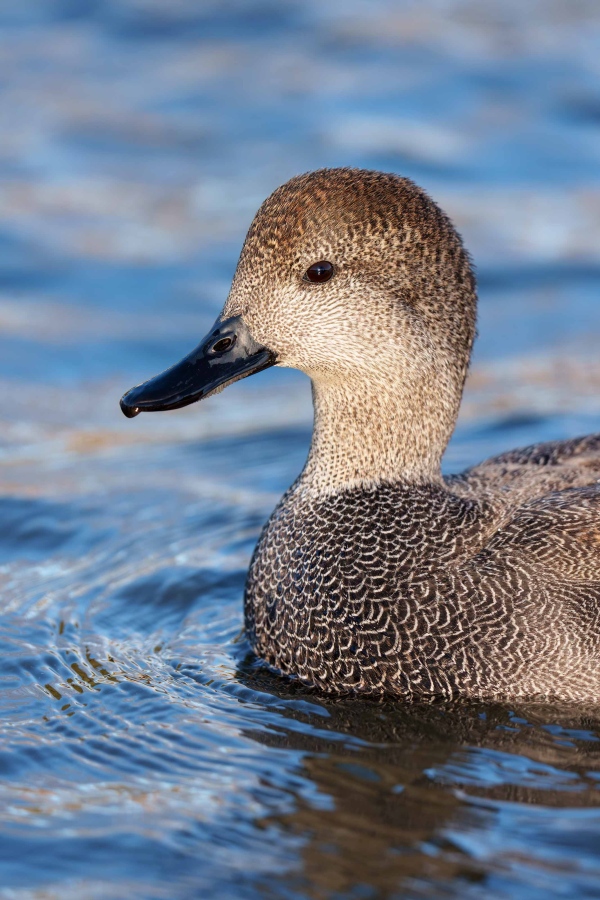
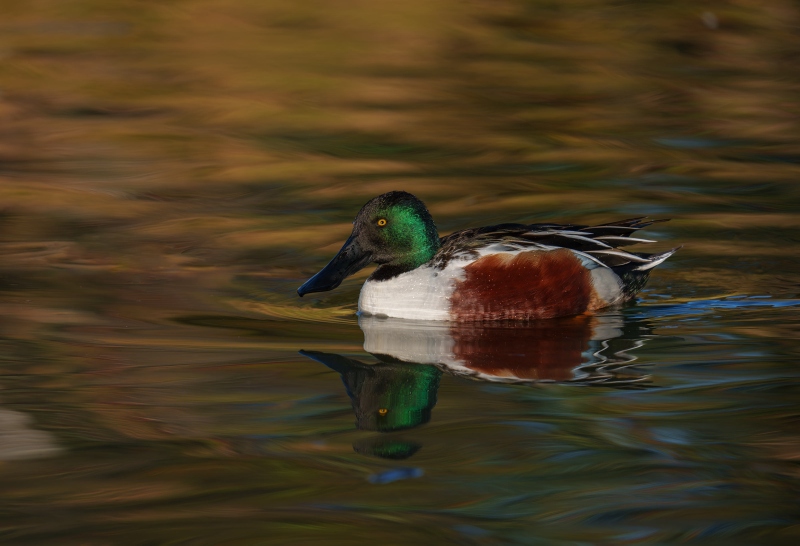
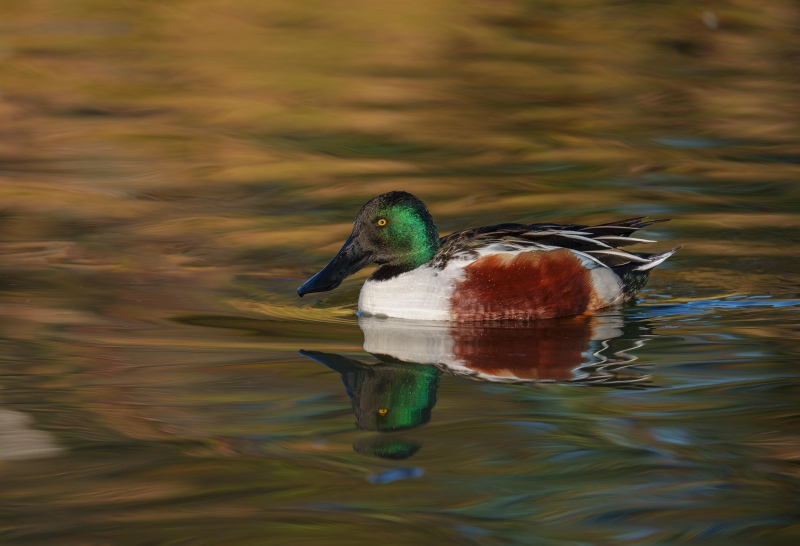
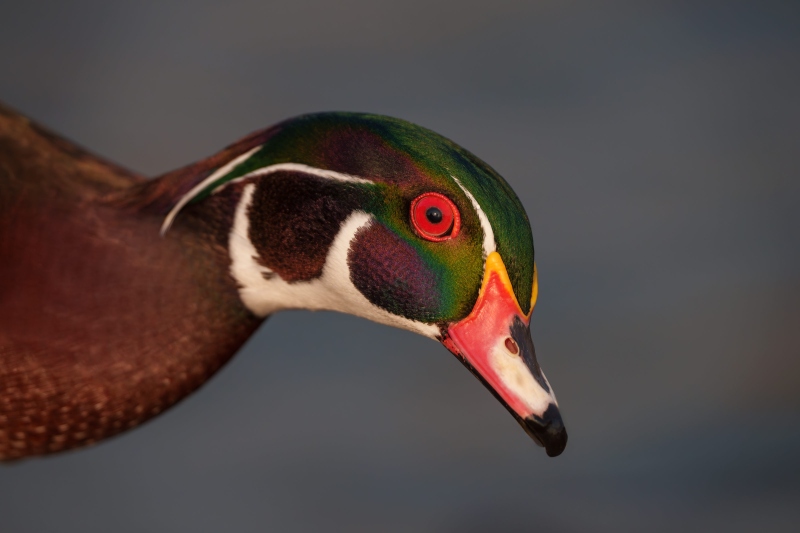
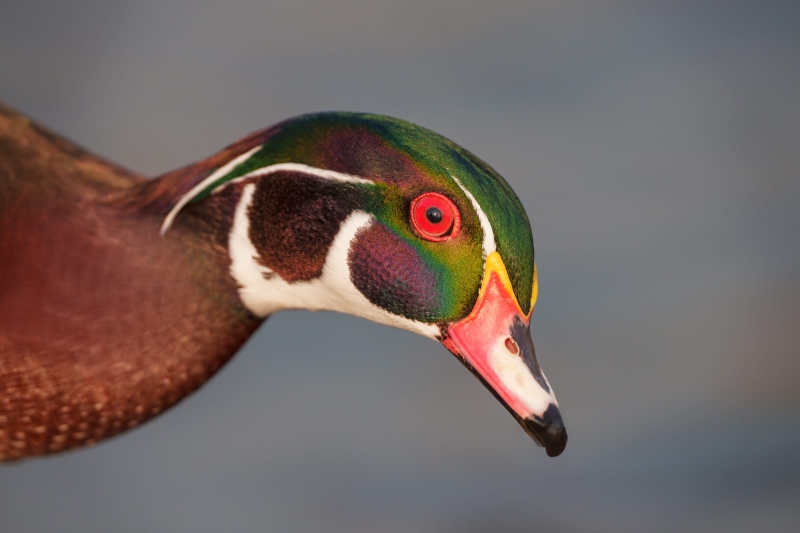
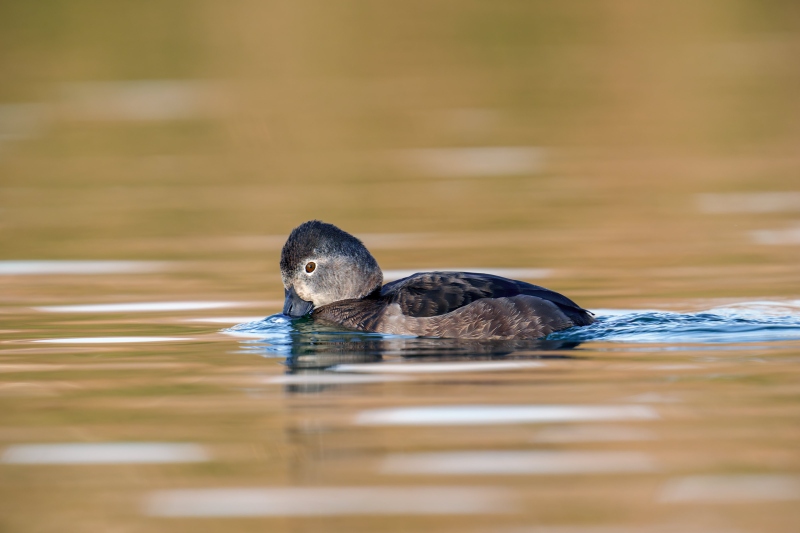









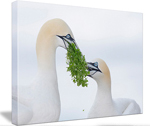



1, 3A, 2A, 3, 2, 4. I love the image 1 composition. 3A and 2A due to exposure. 4 at last due to the pose.
1423
I agree with Maggi. the feather detail is gorgeous and I am right there on the level with the duck making him seem so real. Gorgeous blue water too.
1, 4, 3, 2. Image 2 is much too dark for my taste. I was photographing breeding plumage northern shoveler drakes at Bosque the other day, from the Flight Deck. Ice and good luck kept them close to me in good light. Seventy-seven miles by road is as the crow walks, not flies, no?
You are correct. As the crow flies, it is about 41 miles.
with love, a
ps: see my lighter repost.
Much better to my eye, thanks.
Yes #3 is quite stunning with the head peaking in from the left frame. That composition makes it really stand out! And I know you say exposure was dead on, but I think it would look even better brightened up just a tad.
Thanks, Anthony. Do understand that exposure and presentation brightness are unrelated.
much love, artie
ps: see my lighter repost above 🙂
I love the revision!
Thanks again for your suggestion
with love, artie
Whilst Image 3 is of course, absolutely stunning, there’s something about Image 1 that appeals to me more. I just want to reach out and touch those perfect feathers!
Thanks, Maggi. Drake Gadwall are quite handsome.
with love, artie